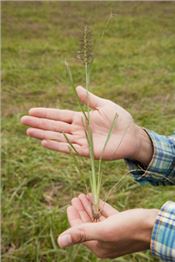Concern Over Ornamental Fountain Grass Invading Pasture Fields

Dr. Anthony Ohmes, agronomy specialist with the University of Missouri Extension,
discusses fountain grass, which is another example of an ornamental
that has made its way into pastures.
Photo by John LaRose Jr.
DR. ANTHONY OHMES
JACKSON, MO.
Sericea lespedeza, johnsongrass, multiflora rose, kudzu, perilla mint and spotted knapweed are some examples of plants introduced to Missouri, either intentionally as an agriculture forage, erosion control, or ornamental or unintentionally through contamination, that have become troublesome weeds to forage and row crop producers. Another example of an ornamental that has made its way into pastures is fountain grass (Pennisetum spp.). Fountain grass is considered an invasive plant in the southwest U.S. and the USDA has a field guide to managing fountain grass:
http://www.fs.usda.gov/Internet/FSE_DOCUMENTS/stelprdb5410113.pdf.
I was asked to look this fall at a grass that was established in some pastures. This particular fountain grass was found at varying densities in a concentrated area of pastures in southeast Missouri. Fountain grass is a warm season perennial bunch grass grown as an ornamental in landscapes. Stems are flat and grow in dense clumps. Sheath margin has white hairs. Leaves are bright green which can deepen to purplish or reddish in color with cooler temperatures and maturity. Fountain grass identifying feature is its purplish, bottlebrush seed head (panicle). It reproduces by seed and germinates in late spring. The seeds are viable, according to USDA guide, for up to 7 years. Seeds have bristles that can attach to animal fur or clothing. Seeds can also be distributed by wind, water and equipment. It appears, in the situation I looked at, seed was inadvertently spread by mowing equipment.
Management of plants such as fountain grass have to be proactive and focus on controlling plants prior to seed production. Management would include physical, cultural and chemical control practices. Physical control would include removing plants, especially if seed heads are visible; mowing plants prior to viable seed production can reduce the number of seed heads but will not stop seed production completely. Cultural control would include promoting landscaping alternatives, especially near and around pastures; maintaining thick competitive pastures to limit infestation of fountain grass; monitor fields, fencerows, rights of way, roads and learn to identify; avoid moving equipment, vehicles, or livestock through a field when seed heads are present and thoroughly inspecting and cleaning equipment before leaving a field. Livestock will not graze fountain grass once it is past early seedling stage. Chemical control is limited to spot spraying with glyphosate and selective grass herbicides. However, fountain grass is a grass and there are no known selective grass herbicides identified that will control fountain grass in a cool season grass pasture; the other chemical option would include a cultural change to a broadleaf crop where selective grass herbicides can be applied.
My knowledge of this plant is limited and as I learn more, I will pass it on. In the meantime it is important to monitor fields for any kind of plant that does not fit in your standard reference of common weeds or desirable plants and manage accordingly. ∆
DR. ANTHONY OHMES: Agronomy Specialist, University of Missouri Extension.

Fountain grass is a warm season perennial bunch
grass grown as an ornamental in landscapes.
Photo by John LaRose Jr.